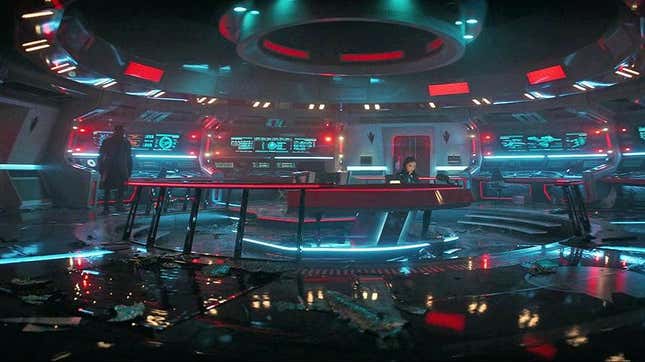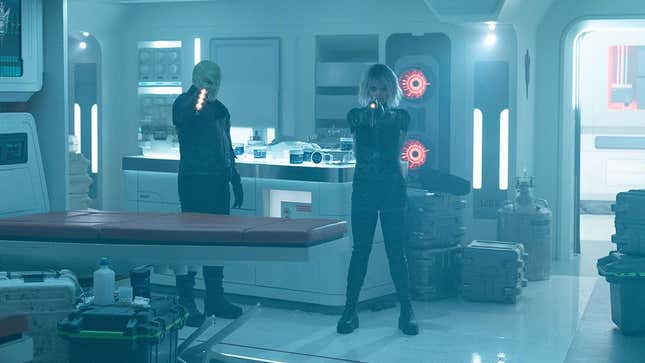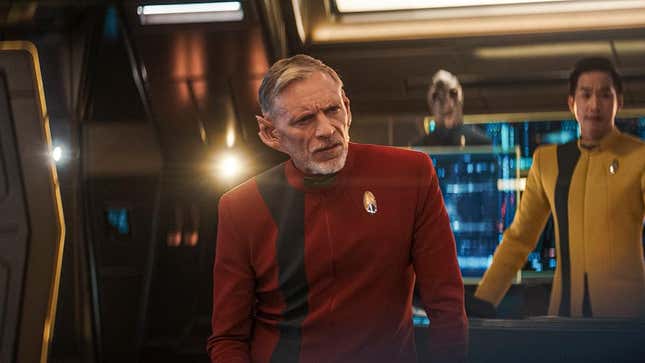We’ve said this many times before, and will no doubt say it a least a few times before as it nears its final end this season: Star Trek: Discovery is not a subtle show. It never has been, but ever since it really found its confidence and understood where its strengths were, it has never shied away from yelling them loudly in the audience’s faces.

Sometimes this works in Discovery’s favor, like it did in last week’s stunningly tight time-twisting adventure—the show firing on all cylinders to play with a format it knows it’s really good at, and using it to do the character reflection it’s also really good at. Sometimes, it means you get an episode like this week’s “Mirrors,” a perfectly perfunctory episode that ties together three different stories—that needed to be told at this point in the season, so you might as well shove them all into the blender and get it out at once—under a familiar dramatic message: Discovery loves Love. It loves romantic love, it loves the love between friends, it loves the bonds love creates to help people change and grow. You, the protagonist: have love! You, the villains of the arc: have love! You, the background support crew: have some love, too!

You know what else this season of Discovery also loves, apparently? Set re-use. After the premiere gave us some clever re-dresses of Discovery hallways and rooms to become the Romulan science ship that kickstarted this whole race-for-progenitor-tech off in the first place, and last week cleverly used the time-hopping conceit to dress and re-dress Discovery again for different eras of the show, this week Michael and Book take themselves on an inadvertent crossover with Star Trek: Strange New Worlds, but not like Lower Decks did. More so that they’re simply just on the Enterprise sets instead! After discovering that Moll and L’ak are hiding out with the next clue in the pocket of extradimensional space—safeguarded by a rapidly opening and closing wormhole entrance—Michael races into action to find them, leaving Commander Rayner in charge back on Discovery and dragging Book along with her, where they discover that the duo, and the clue they seek, is hiding out in the damaged, abandoned remnants of the ISS Enterprise: the Mirror Universe version of the iconic ship.
Alas, Discovery really doesn’t do much to interrogate its own history with Trek’s famous alt-reality; at this point in continuity, Discovery has previously told us, it’s now truly separated from the prime reality, having interdimensionally drifted to the point there’s not been crossover for centuries. Discovery also doesn’t even really explore what it means that the most iconic version of Starfleet’s flagship, twisted into its Terran Imperial form, is now just hanging around, not just as ancient 23rd century technology but filled with materials not of this reality. Sure, at the end of the episode it’s how everyone escaped the destabilizing extradimensional pocket, and Michael taps Owosekun and Detmer to go drag it back to Starfleet for preservation. But really, the ISS Enterprise is here for set dressing: it is the arena in which “Mirrors” dumps its boatload of backstory to fill us in on what’s driving Moll and L’ak.

That is, at least, the interesting thing about “Mirrors”—while it is unsurprising that it turns out Moll and L’ak’s story is about two people cast aside by their societies and former families who find strength and love in their connection, the show does at least give some interesting twists to it all. It turns out L’ak is in fact a member of the classic Trek species the Breen, and cast-out royalty at that, giving an interesting bite to the idea floated last week that it could be them who they ultimately sell the Progenitor tech to should they get their hands on it. It’s also necessary at this point in the season, half-way through, that, well, we actually get motivations for our villains beyond them just getting the thing our heroes want: L’ak has a Breen blood bounty on his head for betraying his people to be with Moll, and all they want is just the opportunity to be free and together and live a life that they define.
It’s interesting! It’s well done! It’s a nice twist for the villains to not just be antagonists for antagonism’s sake! But the show does have to get this all out by slamming the proverbial brakes on its adventure—which happened last week already, but happened last week to give us a really smart use of a classic Star Trek storytelling structure to tell a story that Discovery could only tell knowing it was coming into its final journey, to look back on how far it had changed. Here, the brakes are slammed on to dump a bunch of flashbacks to one specific Breen hangar while our characters hang out on the dimly lit Strange New Worlds backlot. And it’s what we get in the other threads of “Mirrors” too—as we see Michael and Book reflect on their own past together, while Book tries (and regularly fails) to connect with Moll over their shared connection to Booker the Fourth, and as, back on Discovery, we see Rayner try to bring together everything he’s learned about working with this crew to help pull its captain back out from the breach when things start going sideways.

Alone, these are all interesting and necessary kernels of ideas, but mushed together into one story to once again smash over our heads that Connection, Understanding, and Love For Each Other Are Good undermines those ideas a little, and renders them clunkily explored in their own ways. Moll and L’ak largely escape this unscathed as “Mirrors” gives most of itself to their backstory. But that in and of itself feels clunky because it means the thread with Michael and Book half-heartedly acknowledging each other just in case they die feels like an addendum rather than a satisfying point in their shared arc. It means back on Discovery, with barely any time to spare for Rayner’s first big command test without Burnham, we go from knowing absolutely nothing about his Kelleran culture to us and everyone on the ship knowing about five or six different allegedly important parts of its cultural tapestry that it turns out are fundamental to understanding Rayner as a person too. (Admittedly, this is also a Star Trek classic—Trek loves pointing at a single member of a species and tying their entire sociopolitical or theological systems to our understanding of their character.)
Ultimately, it just leaves “Mirrors” as a series of interesting parts that, as a whole, are simply fine. At the end of the day, everyone gets out the extradimensional pocket fine, Mol and L’ak get to half-heartedly escape, and the quest can continue. It’s just now we all know all these characters just want love in the end , and perhaps, most likely—because this is Discovery and it’s what it loves to do most—in the end, the vast majority of them will get it. Necessary stage setting perhaps for this season, but after such an incredible way to center those ideas in the legacy of the show last season, all this feels a bit more like a bump in Discovery’s road.
Want more io9 news? Check out when to expect the latest Marvel, Star Wars, and Star Trek releases, what’s next for the DC Universe on film and TV, and everything you need to know about the future of Doctor Who.

